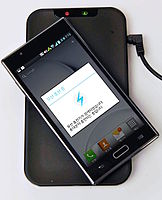
Photo from wikipedia
Future WiFi networks will be powered by renewable sources. They will also have radio frequency (RF)-energy harvesting devices. In these networks, a solar-powered access point (AP) will be tasked with… Click to show full abstract
Future WiFi networks will be powered by renewable sources. They will also have radio frequency (RF)-energy harvesting devices. In these networks, a solar-powered access point (AP) will be tasked with supporting both nonenergy harvesting or legacy data users such as laptops, and RF-energy harvesting sensor devices. A key issue is ensuring the AP uses its harvested energy efficiently. To this end, this article contributes two novel solutions that allow the AP to control its transmit power to meet the data rate requirement of legacy users and also to ensure RF-energy devices harvest sufficient energy to transmit their sensed data. Advantageously, these solutions can be deployed in current wireless networks, and they do not require perfect channel gain information to sensor devices or noncausal energy arrivals at an AP. The first solution uses a deep Q-network (DQN) whilst the second solution uses model predictive control (MPC) to manage the AP’s transmit power subject to its available energy and channel gain to legacy users. Simulation results show that DQN and MPC improve energy efficiency and user satisfaction by, respectively, 16%–35%, and 10%–42% as compared to competing algorithms.
Journal Title: IEEE Systems Journal
Year Published: 2021
Link to full text (if available)
Share on Social Media: Sign Up to like & get
recommendations!